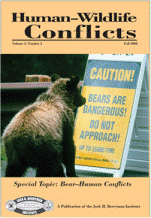Center, Internet, Wildlife Damage Management

Human–Wildlife Interactions
Date of this Version
Fall 2009
Document Type
Article
Abstract
We captured giant Canada geese (Branta canadensis maxima) in 7 counties in eastern South Dakota during the summer molting period, 2000–2003. We attached very high frequency (VHF) transmitters to 150 adult female geese with brood patches, and leg bands to 3,839 geese. We documented molt migrations using VHF telemetry and indirect band recovery at locations north of South Dakota. Telemetry of radio-collared female geese during the breeding season indicated that 56% of nonbreeders, 81% of unsuccessful breeders, and 19% of successful female breeders embarked on a molt migration. Five of 34 geese that underwent molt migrations moved to northeast South Dakota, and the other twenty-nine migrated north of South Dakota. Eighty-six of 647 indirect band recoveries were from north of South Dakota (46º N latitude), suggesting that the geese were molting north of South Dakota. The percentage of indirect recoveries (13%) that occurred north of 46° N latitude was significantly greater (χ2 1 = 160.6, P < 0.001) than northern indirect recoveries (3.5%) reported by Gleason (1997) for giant Canada geese banded in eastern South Dakota from 1955 to 1995. We believe it is likely that 50 to 60% of eastern South Dakota’s population of giant Canada geese undergo molt migrations. These movements affect management strategies in nesting areas, as well as in molting areas. Any management technique, such as egg addling in nesting areas, may reduce local crop damage but increase problems in areas where geese molt. Harvest strategies for molt migrants should involve coordination with state and provincial agencies. Further studies incorporating satellite telemetry are needed to document specifically the molting locations of South Dakota geese.


Comments
Published in Human–Wildlife Conflicts 3(2):260–270, Fall 2009. Published and copyright by Jack H. Berryman Institute http://www.berrymaninstitute.org/journal/index.html